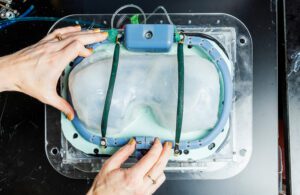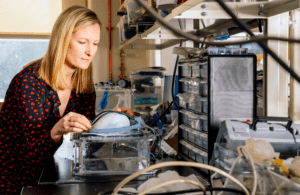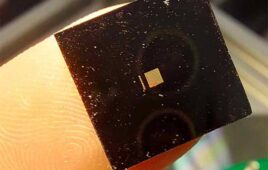
MIT’s implantable ventilator prototype is designed to assist a patient’s diaphragm when it contracts. [Photo by M. Scott Brauer/MIT]
The proof-of-concept design has two soft, balloon-like tubes that are implanted to lie over the diaphragm. The tubes act as artificial muscles to push down the diaphragm to help the lungs expand after being inflated with an external pump, which can be inflated at a frequency to match the diaphragm’s natural rhythm.
For many people, the act of breathing comes naturally. However, the diaphragm’s function can be compromised in people with ALS, muscular dystrophy and other neuromuscular diseases, as well as patients with paralysis and damage to the phrenic nerve, which stimulates the diaphragm to contract.
“This is a proof of concept of a new way to ventilate,” Ellen Roche, associate professor of mechanical engineering and a member of the Institute for Medical Engineering and Science at MIT, said in a news release. “The biomechanics of this design are closer to normal breathing, versus ventilators that push air into the lungs, where you have a mask or tracheostomy. There’s a long road before this will be implanted in a human. But it’s exciting that we could show we could augment ventilation with something implantable.”
The implant’s design grew from Roche’s previous research on assistive devices for the heart. She previously developed a cardiac sleeve designed to wrap around the heart to relieve pressure and provide support as the organ pumps. Her research group found that similar soft, robotic assistance could be applied to other tissues and muscles.

Ellen Roche, associate professor of mechanical engineering, in the lab with the implantable ventilator prototype [Photo by M. Scott Brauer/MIT]
How the implantable ventilator was developed
Conventional ventilators create positive pressure in which air is pushed down through a patient’s central airways and forced into the lungs. However, the diaphragm creates negative pressure that sucks air into the lungs.
The MIT design is a negative pressure ventilator that could augment the natural function of the diaphragm, particularly those with long-term breathing dysfunction.
Two inflatable tubes on the implantable ventilator take after a type of pneumatic device known as McKibben actuators. The tubes lie across the diaphragm from front to back and attach to the ribcage at either side of the dome-shaped muscle. One end of each tube connects to a thin external air line that runs to a small pump and control system.
The pump can be programmed to inflate the tubes at a similar frequency of the diaphragm’s contractions.
“We realized we don’t have to fully mimic exactly how the diaphragm moves — we just have to give it an extra push downward when it naturally contracts,” Roche said.
So far, the researchers have tested the system on anesthetized pigs and implanted the tubes over the animals’ diaphragms. They surgically attach the ends of the tubes to rub on either end of the muscle and monitor the animals’ oxygen levels and observe diaphragm function using ultrasound imaging.
The MIT team of researchers found that, in general, the implantable ventilator increased the pigs’ tidal volume, or the amount of air that the lungs could draw in with every breath. The biggest improvement was seen in cases where the contractions of the diaphragm and the artificial muscles were in sync. The ventilator helped the diaphragm draw in three times the amount of air than it would without assistance.
“We were excited to see we could get such changes in the tidal volume, and we were able to rescue ventilation,” Roche said.
Now the team is working to optimize the system to one day implement it in patients with chronic diaphragm dysfunction.
“The vision is, we know certain parts of this system could be miniaturized,” Roche said. “The pump and control system could be worn on a belt or backpack, or even potentially fully implantable. There are implantable heart pumps, so we know it’s doable. For now, we are learning a lot about the biomechanics and the work of breathing, and how we can augment all that with this new approach.”
The research was published in the journal Nature Biomedical Engineering and was supported in part by CIHR, the Muscular Dystrophy Association, the National Institute of Health, the SICPA Foundation and Lausanne University Hospital Improvement fund, the SMA2 Brown Fellowship and the National Science Foundation.
More from Roche’s lab: New implant design prevents scar tissue without drugs




